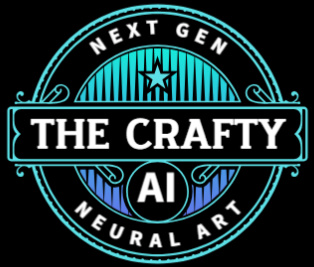www.thecraftyai.com
Upscaling, editing and saving your AI images - Part 7
Once you've created your AI images, the next step is enhancing them through upscaling, editing, and uploading for final use. Upscaling improves resolution and sharpness, making your artwork suitable for printing, websites, or professional portfolios—tools like Topaz Gigapixel, ESRGAN, or built-in upscalers on platforms like Leonardo.ai can help. Editing lets you refine details, correct flaws, or add custom touches using software like Photoshop or free tools like Photopea. Finally, when uploading, be sure to use optimized file formats (like PNG or JPEG), apply metadata or watermarks if needed, and follow platform guidelines to showcase your work safely and professionally across digital channels.
If you want to use your work for print, professional design, or commercial purposes, you’ll want to take one final step: refining the image (Upscaling).
In this Part, you’ll learn how to:
Upscale your images to make them higher quality
Edit or enhance your creations
Save them properly for print or digital use
🔹 Why Upscaling Matters
AI images often look good at first glance, but many are rendered at low resolution (e.g., 512x512 or 1024x1024 pixels). That’s fine for web use, but too small for printing.
To get poster-worthy quality, you need:
High resolution (minimum 300 DPI)
Larger dimensions (at least 2500px on the long side)
🔹 Top Tools to Upscale AI Art
ToolStrengthsURL
Upscale.media: Fast, free, web-based upscaling upscale.media
Let’s Enhance: Great for portraits and prints, paid plans letsenhance.io
Topaz Gigapixel AI: Advanced desktop app, excellent quality to pazlabs.com
Tip: Upscale after you’re happy with the image, not before editing.
🔹 Editing AI Images
Even the best AI image may need some tweaking, especially if you want to:
Fix small details (hands, eyes, artifacts)
Add text or branding
Combine multiple AI images into a collage
Recolor or apply filters
Easy Editors You Can Use:
Canva (Free & Pro) – Great for design, overlays, and layout work
Pixlr (Free) – Fast online Photoshop-style editor
Photoshop – Best for advanced editing and layering
Photopea – Free browser-based editor that mimics Photoshop
You can also edit AI images in tools like Leonardo AI and DALL·E, which allow inpainting (fixing or adding to certain parts of an image).
🔹 Saving Your Work: File Types & Tips
When saving your final images, consider these formats:
JPG General use, web, small file sizes. Most compatible and easy to share
PNG Transparent backgrounds, sharper edgesIdeal for graphic design
PDF Print documents, posters, multi-page layoutsUsed for eBooks and guides
TIFF Professional printing, no quality lossLarge file sizes
✅ Always save your high-resolution master file—even if you export smaller versions for web.
💡 Pro Tip: Name your files clearly (e.g., CyberDragon_4K_300dpi.jpg) and organize them by project or use.
🔹 Example Workflow: From AI to Final Product
Generate your image on whichever platform you are using
Upscale it with Upscale.media or Gigapixel
Edit it in Canva (add title or borders)
Save it as a PNG or JPG at full size
Upload it to your website, shop, or print service
🔹 Print-Ready Settings Checklist
Before you print or sell your image, make sure it meets the following:
✅ At least 300 DPI
✅ Size matches your print size (e.g., 11"x17", A4, 18"x24")
✅ Clean edges (no unwanted AI blur or artifacts)
✅ Final edits applied (color balance, lighting tweaks)
✅ Saved in JPG, PNG, or TIFF with high quality
🔹 Final Thought
Your AI-generated image is the starting point—but it becomes so much more when you take a few extra steps to refine it. Think of upscaling and editing as the final polish that transforms your idea into something ready for the world—whether online, in print, or framed on a wall.
© 2025. All rights reserved.

